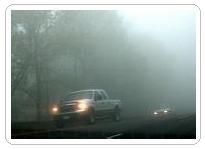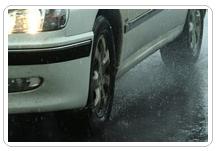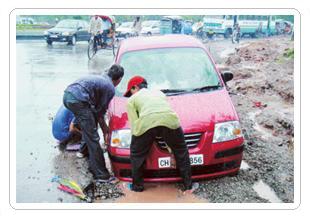|
|
|
HAZARDOUS CONDITIONS
Driving in the fog The best advice for fog is to avoid driving in it altogether. Serious pile-up accidents involving multiple vehicles frequently occur in severe fog. You should consider postponing your trip until the fog clears. Obtaining maximum visibility and reducing glare If you must drive in the fog, then slow down and turn your low beam headlights on (and fog lights, if you have them). The light from high beam headlights will reflect back and cause serious glare, so you should not use them in the fog. Never drive with just your fog or parking lights on, whether or not there is fog. Use your windshield wipers and defroster to clear your windshield for the best vision. You should increase the space cushion (following distance) in front of your vehicle and be prepared to stop within the space you can see in front of your vehicle. Avoid crossing or passing long lanes of traffic unless absolutely necessary. Keep headlights and taillights clean. When dirt, they are less bright and less visible to other drivers and pedestrians. If visibility is poor, roll down your window and turn off your radio so you can listen for vehicles you cannot see. You should watch for slow moving vehicles ahead and check your rear-view mirror for vehicles approaching from the rear. Only use your brakes when you need to; do not repeatedly flash your brake lights for no reason because it will confuse other drivers behind you. If the fog becomes so thick that you can barely see, pull completely off the road. Get off at an exit or rest stop, if possible, and wait for conditions to improve. Do not continue driving until you can see better. Turn off you lights, or another driver may see your taillights pull in behind you thinking you are on the roadway. If your vehicle stalls in the fog, you should:
Dust storms and smoke Certain parts of USA are prone to have large dust storms which limit your visibility similar to fog. If you can avoid driving in a dust storm, stay off the road. If you must drive, use the methods prescribed for driving in fog. If smoke from a large fire such as a wildfire obstructs your ability to see the road ahead and be seen by other drivers, use the methods prescribed for driving in fog. If you can avoid driving through smoky areas, do so.
Driving in the rain While driving in the rain, you should:
Use your low-beam headlights whenever it is raining. To improve visibility, you may have to stop to wipe mud or snow off of your windshield, headlights, and taillights. Slow down at the first sign of rain, drizzle, or snow on the road. This is when many road pavements are most slippery because oil and dust have not been washed off the roadway. In other words, the roadway is usually the most slippery when it just starts to rain and it has not rained for some time. If the road is slippery, it will not give your tires the traction they need to make quick stops, and maneuver turns and corners. You must drive more slowly than you would on a dry road. If it starts to rain on a hot day, pavement can be slippery for the first few minutes. Heat causes the oil in the asphalt to come to the surface. It makes the road more slippery until the oil is washed away. If the roadway is wet, you should travel at least 5 to 10 MPH slower than you normally would. In a very heavy rainstorm, you may not be able to see more than 100 feet ahead. When you cannot see any farther than that, you cannot safely drive faster than 30 MPH. Choose a speed consistent with the amount of water on the road. At 30 miles per hour or less, properly inflated tires with good tread will maintain contact. Even a brand-new tire will lose some footprint contact at 35 miles per hour. At 50 miles per hour, water may separate the tire from the road and cause hydroplaning. Going through deep water
If you encounter deep water on the roadway, you should drive around it or take another route, if possible. Never drive through water that is deep enough to reach the bottom of your vehicle. If you're not sure, don't try it. If you must drive through water on the roadway, avoid letting water splash into the engine compartment by driving slowly. Water may stop your engine completely and leave you stranded in a the middle of the water. Do not pass through strong currents are that are high enough to reach the bottom of your vehicle because they can carry the vehicle away. Hydroplaning Hydroplaning is a product of vehicle weight, speed, tire width and tread depth. Hydroplaning is when your tires lose contact with the road and are riding on a thin sheet of water. You have no traction while hydroplaning. It can occur at 50 mph or less in heavy rain, and is more likely to happen if your speed is high, your tires lack tread depth, and your vehicle is light. A slight gust of wind could throw your vehicle into a skid. To regain control, you need to take your foot off the accelerator, but do not brake. You should slow down whenever there is a lot of water on the road to avoid hydroplaning. Look for signs of hydroplaning such as standing water, raindrops that bubble on the road or a sloshing sound from your tires. This is your opportunity to slow down and avoid hard braking or turning sharply. Drive in the tracks of the vehicle ahead of you and increase the distance between you and the forward vehicle. If it begins to rain so hard while you are driving that you cannot see very far in front of your vehicle, slow down and get off the roadway as soon as possible. Be careful of other drivers who have also reduced their speed or who are exiting the roadway as well. Keep your parking or hazard lights on when parked on the side of the road.
Driving in snow and ice Sometimes a road that is normally safe becomes dangerous when slippery. Ice and packed snow on the road can cause your vehicle to skid, especially if you are driving fast or traveling downhill. You should always use your low beams on frosty mornings when other drivers' windows may be icy or foggy. Do not use your high beams in a snow storm because they will reflect off of the falling snow and blind you. To drive safely in snow or ice you should:
If you will be driving in an area where it has snowed or may snow, carry chains in case you find yourself in conditions where you can't drive without them. Make sure you carry the correct number of chains and that they will fit your drive wheels (which is your front wheels in a front-wheel drive vehicle, your rear-wheels in a rear wheel drive vehicle, and all wheels in an all-wheel drive vehicle). Learn how to put the chains on your vehicle before you need to use them. Check the weather before you leave. When driving on roadways where snow chains are required, temporary special speed limits may be posted which you must obey. These speed limits range from 25 to 40 MPH. When driving on packed snow, you should drive at least 50% slower than you normally would. If there is ice on the road, you should slow to a crawl. Some road surfaces are more slippery than others when wet. These roads often have warning signs. Here are some clues to help you spot slippery roads: (a) on cold and/or wet days, shade from trees, buildings, and under over-overpasses can hide spots of ice-- these areas freeze first and dry out last, (b) bridges and overpasses can also hide spots of ice-- they tend to freeze before the rest of the road does, and (c) close to the freezing point, the road is icy and may be more slippery than at colder temperatures. In USA, we also have a special problem with "black ice." Black ice is very difficult to see on the roadway and appears more like a wet spot than a patch of ice. Even when you see no apparent ice on the roadway, black ice may be present. Black ice is likely to form on shady parts of the roadway such as the back sides of turns or hills. Slow down and be especially careful when the weather is cold enough to form black ice. How to stop skidding To stop skidding you should:
If you go into a skid, ease off the gas pedal, stop braking, and turn the steering wheel in the direction you want the vehicle to go. If you can't control your vehicle on a slippery surface, try to find something to stop you. Try to get a wheel on dry pavement or on the shoulder of the road. You may have to slowly edge into a snow bank or some bushes to stop. To help avoid skidding on slippery surfaces, you should:
When stuck in snow or mud You can avoid getting stuck in snow or mud if you carry chains in your vehicle and put them on the tires before driving in snow or mud. If you encounter muddy or slushy conditions, you need steady pulling and moderate power when traction is poor. The best remedy when wheels are stuck in snow, mud, or a soft shoulder is to apply power slowly. Keep your front wheels pointed straight ahead so the vehicle can move in a straight line. If you can’t go forward, try backing out, steering in the vehicle’s tracks. If one of the drive wheels becomes stuck, the centrifugal forces created by rapidly spinning your tires can cause an explosion by literally tearing the tire apart. Never exceed the 35 mph indicated speedometer speed or stand near the spinning tire. To recover when you are stuck in mud or snow: How to rock out
|
 Content
Of Online Course
Content
Of Online Course

